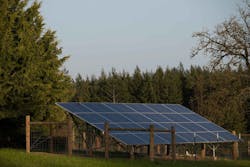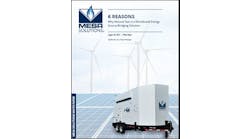Demand Response Aggregation Bans Partially Lifted in 2 States; 10 More to Go. Microgrids, DERs Benefit
Distributed energy resource (DER) aggregators are hoping that 10 states will use a recent Missouri Public Service Commission (PSC) ruling as a model for allowing third-party aggregators to pool microgrid batteries and other DERs and bid them into wholesale market demand response programs.
On Oct. 12, a Missouri PSC ruling partially lifted the state’s 2010 ban on third-party demand response aggregations.
The 10 states now ban aggregation of demand response for the purpose of bidding into wholesale markets. In addition, an eleventh state – Indiana – only allows demand response aggregation through the utility. And Michigan, like Missouri, has partially lifted its ban, said Allison Bates Wannup, a regulatory consultant and former senior director of regulatory affairs at Voltus, a virtual power plant operator of DERs.
Partial lift of ban to help PSC gain experience
The partial — rather than complete — lifting of the ban aims to help the Missouri PSC gain some experience with aggregators before allowing them to work with all customers. Currently, only qualifying commercial and industrial customers can participate in the aggregated demand response programs, said Peter Dotson-Westphalen, senior director of regulatory and government affairs for CPower, an aggregator of retail customers (ARC).
For these customers, microgrids and the grid, the Missouri PSC move is a win because it allows DER and microgrid owners to provide much needed demand response when the grid is stressed – and get paid for it. Now aggregators such as CPower can contract directly with qualifying Missouri customers and benefit the grid.
“These resources do provide regular grid reliability and renewables integration,” said Wannup. “When there’s a small variation or dip in renewables, this load is well-suited to provide support for short intervals.”
Aggregators support the grid during energy emergencies
More and more, aggregators are playing an important role in improving grid reliability and reaping income for DER owners, especially during the increasing number of grid emergencies. For example, CPower’s customers provided more than 50 GWh of load during Winter Storm Elliott in late December 2022.
That’s equivalent to the daily energy use of more than 1.7 million homes, according to CPower.
Since CPower was founded in 2015, the company has paid out more than $1 billion in grid revenues to customers, Dotson-Westphalen said.
In 2020, homeowners were paid $1 million to help the grid
During an August 2020 heat wave, OhmConnect – another aggregator – helped meet demand for electricity from the strained grid by controlling the smart devices, microgrids and appliances of 150,000 residential customers, providing 1 GWh for the grid, the equivalent of taking 600,000 homes off the grid. It paid $1 million to its homeowner customers.
The states that still ban aggregation of demand response are missing out on such benefits.
Missouri and Michigan were among the 13 states in Midcontinent Independent System Operator and Southwest Power Pool territories that opted out of allowing aggregators to directly bid demand response into regional transmission organization (RTO) and independent system operator (ISO) wholesale markets, said Wannup.
The bans stem from the early days of competitive markets and the lack of clarity about who would regulate demand response, explained Kenneth Schisler, senior vice president of regulatory and government affairs for CPower and former chairman of the Maryland Public Service Commission.
FERC orders opened up wholesale markets to DERs
In 2008, the Federal Energy Regulatory Commission (FERC) issued Order 719, which directed ISOs and RTOs to amend their tariffs and improve competition in organized wholesale markets. The goal of Order 718 was to reduce barriers to the participation of demand response in markets.
FERC defined the role for ARCs to bid demand response services directly into organized wholesale markets. But it also allowed states to opt out of allowing demand response aggregators to bid into the markets, Schisler said. FERC left it up to the states to decide, and 13 states enacted bans prohibiting third-party demand response aggregators to bid into the markets.
“States opted out because they wanted regulatory control, and utilities were likely espousing a parade of horrible risks of allowing third parties into markets,” said Schisler. “States were saying, ‘We want to understand what the market looks like.’ It was a period of uncertainty.”
In September 2020, FERC issued a landmark ruling, Order 2222, which paved the way for aggregated DERs to compete alongside traditional power plants and other grid resources in wholesale markets.
But in that order, FERC still allowed states to opt out of allowing third-party aggregators to bid demand response into wholesale markets, Schisler explained.
Missouri’s effort was a public-private partnership
Missouri’s efforts to change the demand response ban are a model for other states interested in walking back their own bans, said Wannup. The Missouri PSC’s move was a public-private sector collaboration.
Initially, technology companies, including Voltus, CPower and Advanced Energy Management Alliance worked together to create interest in the benefits of demand response programs.
As part of the overall effort, the Missouri PSC also applied for and received a technical assistance grant from the federal Department of Energy (DOE), which resulted in a report from Lawrence Berkeley National Laboratory that explained ways to lift the aggregator bans.
Seeking a cost-effective and reliable grid
“I think that it is an example of various entities working together and how they can use resources available to get support and feel comfortable with these changes. That absolutely has to happen in order to have a cost-effective reliable grid that integrates DERs,” said Wannup.
Slowly, the bans are being addressed.
Michigan first loosened its restrictions in 2019 to allow aggregators of retail choice customers and loosened them again in 2022 to allow aggregators of larger commercial and industrial customer resources in certain territories, according to the Lawrence Berkeley National Lab report.
Arkansas chose not to reverse the opt out, but others – including Indiana and Minnesota – are now looking into possibly addressing aggregation, said the report.
And that’s progress, hopefully following the lead of Missouri.
“At the end of the day, you have a state, with the help of the DOE, getting rid of an outdated rule to have a more responsive grid,” said Wannup. “We need to enable everyone to do what they need to do to build the grid of the future.”
Track news on new microgrid projects. Subscribe to the free Microgrid Knowledge Newsletter.







